Hello, travelers! I’m Michael Zhang, a passionate adventurer and travel enthusiast from China. Over the years, I’ve explored countless destinations across the globe, delving into the history, culture, and breathtaking landscapes that make each place unique. Today, I invite you to join me on a journey to Mount Hua (Huashan), one of China’s Five Great Mountains. Renowned for its stunning natural beauty and rich cultural heritage, Mount Hua is a destination that every traveler should experience at least once.
Summary
- About Mount Hua
- Mount Hua Map
- Why Visit Mount Hua?
- Cultural and Historical Significance
- Things to Do at Mount Hua
- Night Climbing Route
- Sunrise and Sunset Timings at Mount Hua
- Post-Hike Tips for Mount Hua
- Best Time to Visit Mount Hua
- How to Get from Xi’an to Mount Hua
- Accommodations at Mount Hua
- Food Recommendations at Mount Hua
- FAQ
About Mount Hua
Mount Hua, also known as Huashan, is one of the most famous mountains in China. It is a 5A-rated scenic spot and one of the Five Great Mountains. Known for its breathtaking cliffs and dramatic peaks, Mount Hua is often called “The Most Dangerous Mountain Under Heaven.”
- Location: Shanxi Province, Huayin City, Jiling Road; approximately 120 kilometers from Xi’an (Apple Maps/Amap)
- Opening Hours:
- Cable Car Entrances: Open from 7:00 AM to 4:00 PM, with cable car operations running until 7:00 PM.
- Walking Trail (Huashan Gate): Open 24 hours.
- Recommended Visit Duration:
- By Cable Car: Around 4–5 hours.
- By Foot: Approximately 8–10 hours or more, depending on your pace.
- Best Seasons to Visit: Mount Hua is beautiful year-round. However, the best times are spring (March to May) and autumn (September to November). Summer (June to August) is ideal for lush greenery, while winter (December to February) offers magical snowy landscapes.
- Ticket Purchase: Trip.com Discounts
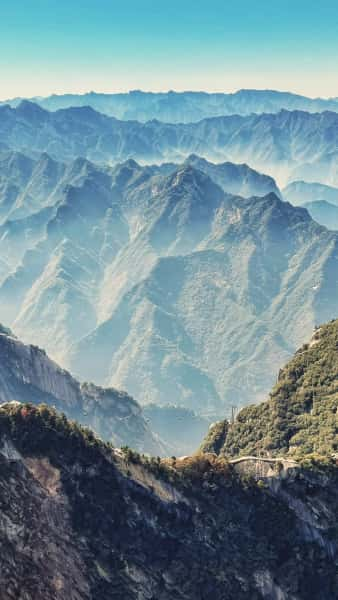
Mount Hua Map
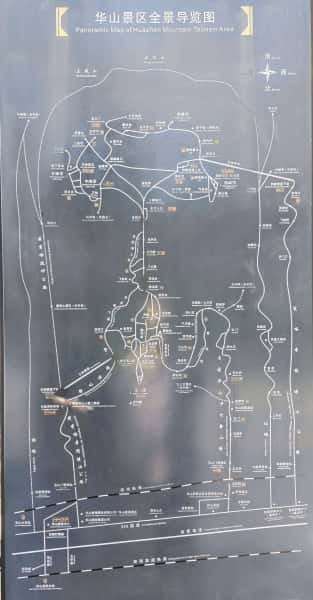
Why Visit Mount Hua?
Breathtaking Natural Scenery
Mount Hua is renowned for its dramatic landscapes. With five towering peaks shrouded in mist, the mountain offers an ethereal experience. The scenery changes with the seasons:
- Spring: Blooming flowers carpet the trails.
- Summer: Verdant forests provide cool shade.
- Autumn: Fiery red and golden leaves create a painterly scene.
- Winter: Snow-covered cliffs transform the mountain into a serene wonderland.
The unique granite formations and towering cliffs make Mount Hua a natural marvel unlike any other.
Rich Cultural Heritage
As one of the cradles of Chinese civilization, Mount Hua is deeply rooted in history and culture.
- It is considered the “Root of Chinese Culture” as the term “Hua” in “China” originates from Mount Hua.
- The mountain is a sacred site for Taoism, featuring 72 hanging caves and 20+ Taoist temples.
- Historical legends, such as “Splitting the Mountain to Save Mother” and “Blowing the Flute to Attract the Phoenix,” add a mythical charm to the mountain.
- Ancient emperors like Qin Shi Huang and Tang Xuanzong conducted grand rituals here, leaving behind over 1,200 inscriptions and stone carvings.
Thrilling Challenges and Adventures
Mount Hua’s daring trails make it a bucket-list destination for adventurers:
- The Plank Walk (Chang Kong Cliff Path): A narrow wooden path bolted into the cliff face, offering both thrills and unmatched views.
- Sparrow Hawk Turn (Yaozi Fanshen): A vertical climb requiring visitors to hold onto chains as they ascend.
- These trails test your physical endurance and courage, providing a sense of accomplishment that’s hard to match.
Spectacular Sunrises and Sunsets
The East Peak of Mount Hua is the best spot to catch the sunrise, while the West Peak offers stunning sunset views. Imagine the sun emerging from the clouds, illuminating the rugged mountain peaks—a sight that will leave you in awe.
Cultural and Historical Significance
Mount Hua holds a special place in Chinese culture and history:
- The mountain served as a sacrificial site during ancient times. Notable emperors like Qin Shi Huang and Wu Zetian performed grand ceremonies here.
- Taoism flourished at Mount Hua, with sites like the West Dark Cave known as the “Fourth Heavenly Cave” in Taoism.
- Numerous Taoist masters, such as Chen Tuan and Hao Datong, practiced here, contributing to its spiritual importance.
- The mountain boasts over 1,200 poems and inscriptions carved into its rocks, narrating centuries of human reverence.
Things to Do at Mount Hua
Must-See Attractions
Chang Kong Cliff Walk
The Chang Kong Cliff Walk is located on the eastern side of the South Peak, midway up the mountain. This daring plank trail was originally built by He Zhizhen, a Yuan Dynasty Taoist master who sought seclusion and enlightenment in the mountains. The path consists of narrow wooden planks secured to the cliff face with metal stakes, with only iron chains for support. Visitors must inch along the plank while hugging the cliff wall, which adds to the thrill and challenge. Known as the “First Risk of Mount Hua,” it’s an adventure that will test your nerves.
- Ticket Price: ¥30
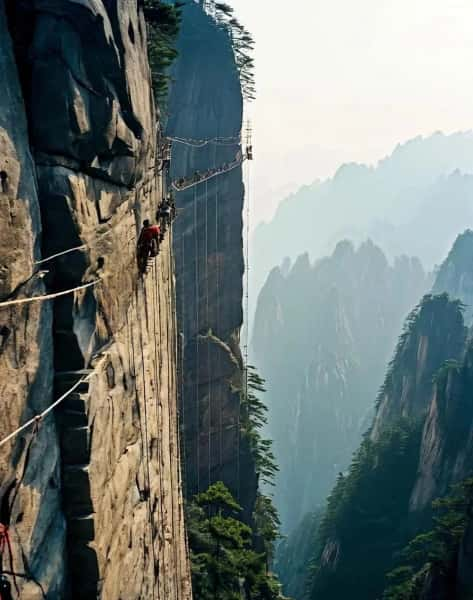
Sparrow Hawk Turn (Yaozi Fanshen)
As the “Second Risk of Mount Hua,” Sparrow Hawk Turn is a steep and narrow cliffside path on the East Peak. The trail leads to Chess Pavilion and gets its name from its resemblance to a sparrow hawk’s wings. Visitors must cling to chains while carefully stepping down into small footholds carved into the rock. It’s a breathtaking experience that combines adrenaline with stunning mountain views.
- Ticket Price: ¥30
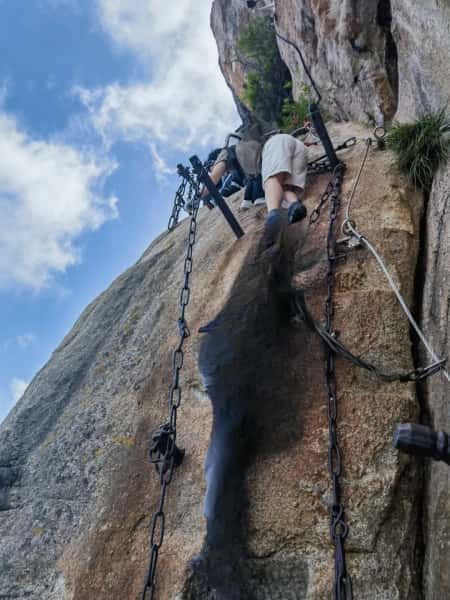
Lao Jun Plough Ditch
Lao Jun Plough Ditch, also known as “Lao Jun Li Gou,” is the “Third Risk of Mount Hua.” The name originates from a Taoist phrase meaning “leaving worldly impurities behind to reach enlightenment.” The ditch is a deep, narrow ravine between towering rock faces, with over 570 steep stone steps. According to legend, Laozi, the founder of Taoism, plowed this pathway overnight with the help of a divine ox to make the mountain accessible. Today, visitors can see grooves resembling plough marks along the cliffside, adding a mythical touch to this challenging route.
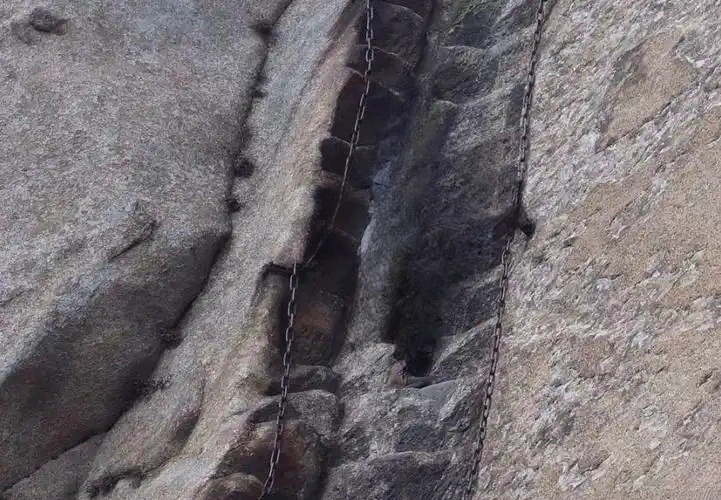
Thousand-Foot Precipice (Qianchi Zhuang)
Located above Hui Xin Stone, Thousand-Foot Precipice is a narrow fissure between two massive cliffs. The path features over 370 steep stone steps, each only about one-third the width of a foot, with an incline of 70°. Two iron chains hang vertically along the trail, providing essential support. At the top, hikers must pass through a small rock opening called the “Heavenly Well,” which has earned its reputation as “Mount Hua’s First Dangerous Passage.”
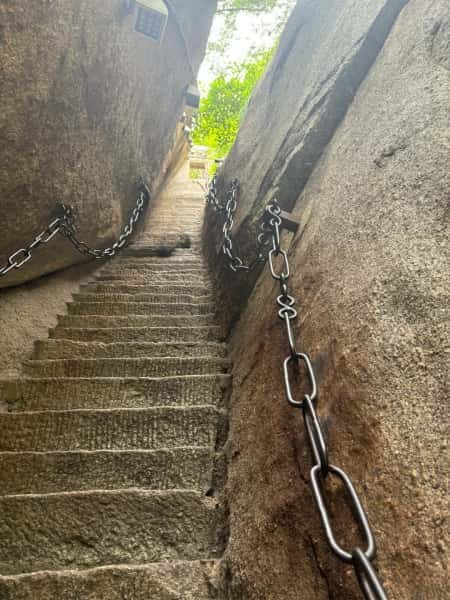
Hundred-Foot Gorge (Baichi Xia)
Also known as “Hundred-Zhang Cliff,” Hundred-Foot Gorge lies just beyond Thousand-Foot Precipice and marks the second major challenge for hikers ascending Mount Hua. The path, which stretches 46 meters and includes 91 narrow stone steps, is carved into nearly vertical rock faces. First built in the late Ming and early Qing dynasties, the trail has undergone several renovations to maintain safety while preserving its adventurous character. Climbers must use iron chains for stability, adding a thrilling element to this picturesque section of the hike.
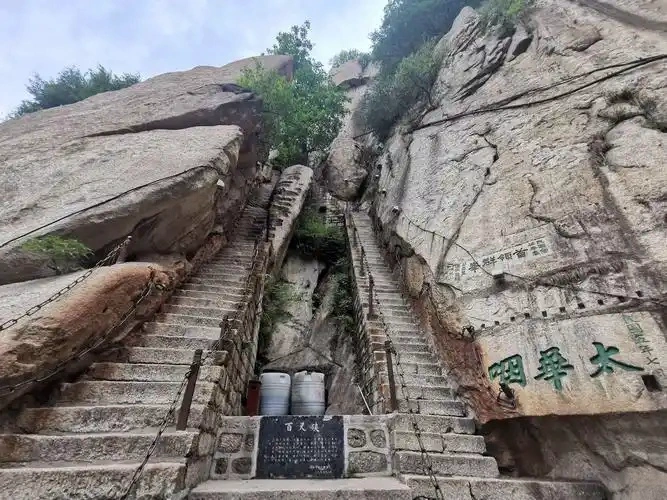
Xiyue Temple
Located 5 kilometers from the Mount Hua Visitor Center, Xiyue Temple is a historic site where emperors of past dynasties held grand ceremonies to honor the god Shao Hao of Mount Hua. Built in 134 BCE, the temple has a history spanning over 2,100 years. It underwent expansions and renovations through the centuries, culminating in its final restoration during Emperor Qianlong’s reign, modeled after Beijing’s Forbidden City. Known as the “Mini Forbidden City of Shaanxi,” Xiyue Temple is the largest surviving Ming and Qing imperial palace-style complex in northwest China. Its symmetrical layout and impressive scale make it the largest temple among the Five Great Mountains, earning it the nickname “First Temple of the Five Peaks.” Key features include Jin Cheng Gate, Lingxing Gate, Stone Archways, Haoling Hall, and other architectural marvels.
- Ticket Price: ¥15
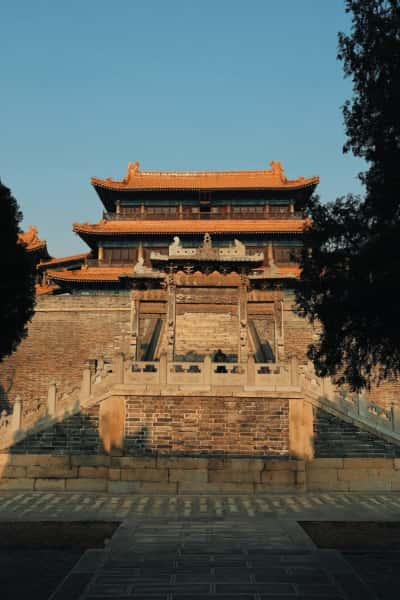
Golden Lock Pass (Jinsuo Guan)
Also called “Heavenly Gate,” this stone archway at the confluence of the Middle, East, South, and West Peaks serves as a vital path connecting these summit routes. Perched between sheer cliffs, the path leading to the pass is just a meter wide, making it a thrilling passage. The original gate, built by Ming Dynasty Taoist Hu Zhenhai, was destroyed and later rebuilt in 1985. The Golden Lock Pass is celebrated in the famous poem by Du Fu: “In valleys, carts can’t return; the Heavenly Gate is the sole way forward.” Beyond this point, hikers often say, “Another world awaits past the Golden Lock Pass.”
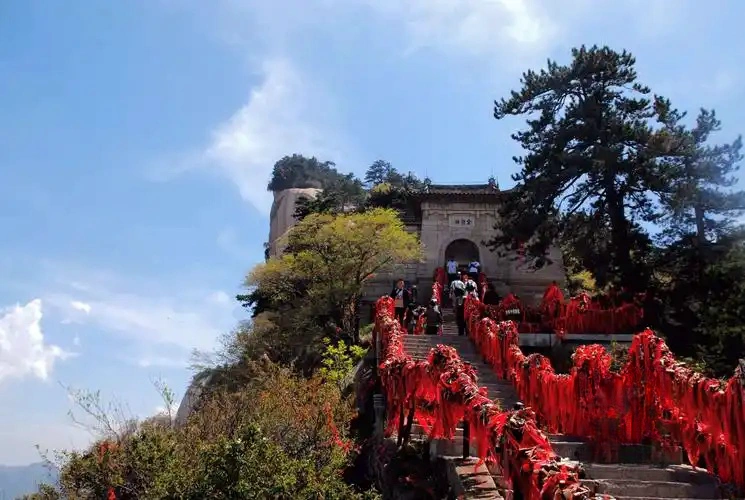
Canglong Ridge (Azure Dragon Ridge)
Canglong Ridge is a knife-edged ridge connecting Jiuku Terrace to Wuyun Peak. This iconic path, one of Mount Hua’s most famous trails, stretches over 100 meters and is less than a meter wide. Its steep slopes and dragon-like appearance gave it its name. The ridge is flanked by deep valleys—Qingke Valley to the west and Feiyu Valley to the east. Historically, poet Han Yu famously wrote about crying here during his desperate ascent. In the Qing Dynasty, major repairs added 250 stone steps, making the ridge more accessible while maintaining its adventurous spirit.
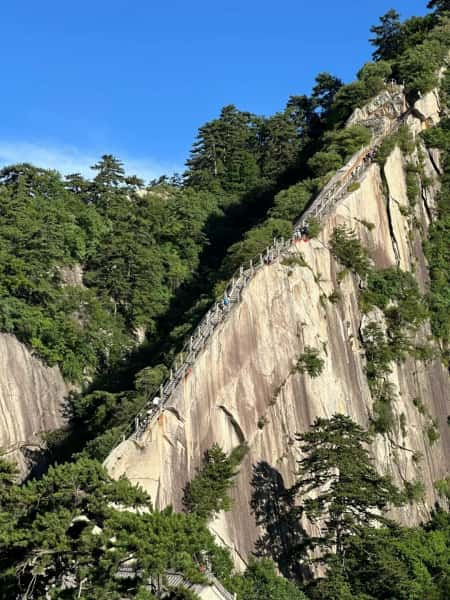
North Peak (Cloud Terrace Peak)
The North Peak, or Yun Tai Feng, stands at 1,614.7 meters and is the lowest of Mount Hua’s five main peaks. Surrounded by sheer cliffs on three sides, it is a starting or connecting point for routes to other peaks. The peak’s landmarks include Zhenwu Temple, Changchun Stone Chamber, and Iron Bull Terrace. Known for its stunning views, the North Peak was also the site of a famous military operation, “Taking Mount Hua by Strategy,” commemorated by a pavilion near Zhenwu Temple.
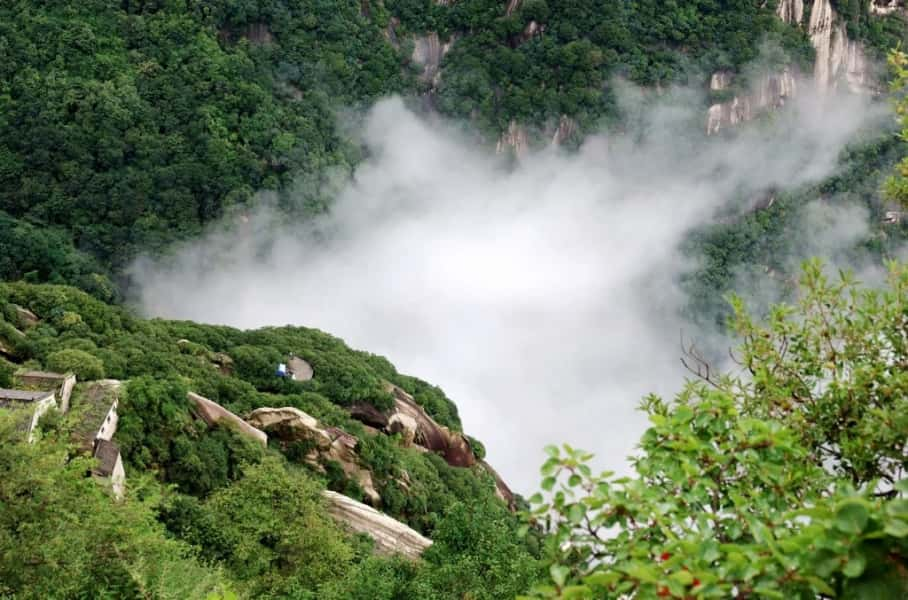
West Peak (Lotus Peak)
At 2,082.9 meters, the West Peak is named for its lotus-shaped rock formations. Known as Lianhua Feng or “Lotus Peak,” it is steeped in myth and legend. Key attractions include Lotus Cave, Giant’s Footprint, and Dragon Ridge. The peak is closely associated with the Taoist legend of “Splitting the Mountain to Save Mother,” a story deeply embedded in Chinese folklore. The ridge connecting the West and South Peaks, known as “Qu Ling” (Curved Ridge), offers dramatic views and thrilling trails.
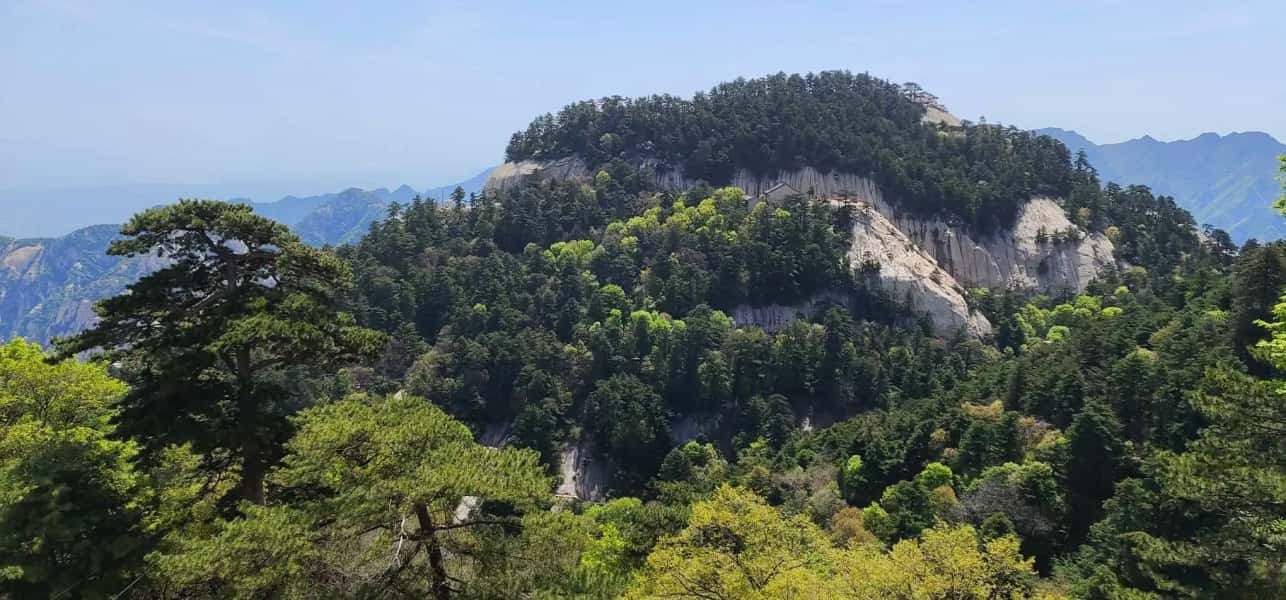
South Peak (Goose-Returning Peak)
At 2,160.5 meters, South Peak is the highest summit of Mount Hua and is known as “The Head of Mount Hua.” The peak comprises two sections: Songgui Peak, covered in ancient pine and cypress trees, and Luoyan Peak, named after the geese that rest here during migration. Notable sights include White Emperor Temple, Black Dragon Pool, and the iconic Welcome Pine. The serene landscape and commanding views make it a favorite among visitors.
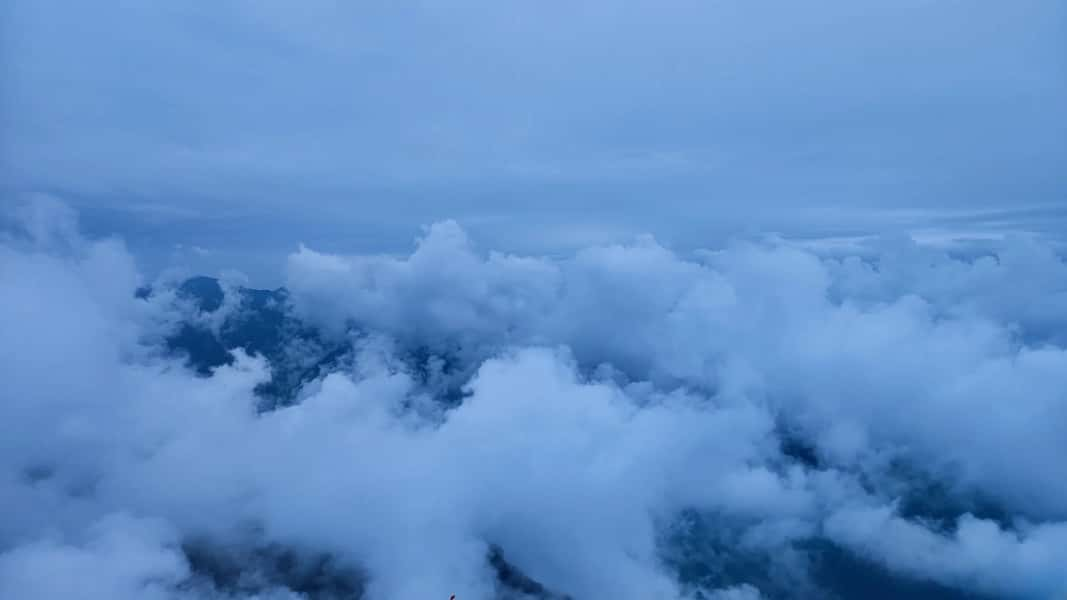
East Peak (Sunrise Peak)
Standing at 2,090.9 meters, East Peak is renowned for its expansive views and as the best location to watch the sunrise. Known as “Sunrise Peak,” its main attraction is the Sunrise Viewing Platform, where visitors gather early in the morning to witness the sun rising above the clouds. Other highlights include Jade Maiden Peak and Immortal Palm Cliff, where legend says the Yellow River deity left a handprint while carving paths for the river to flow.
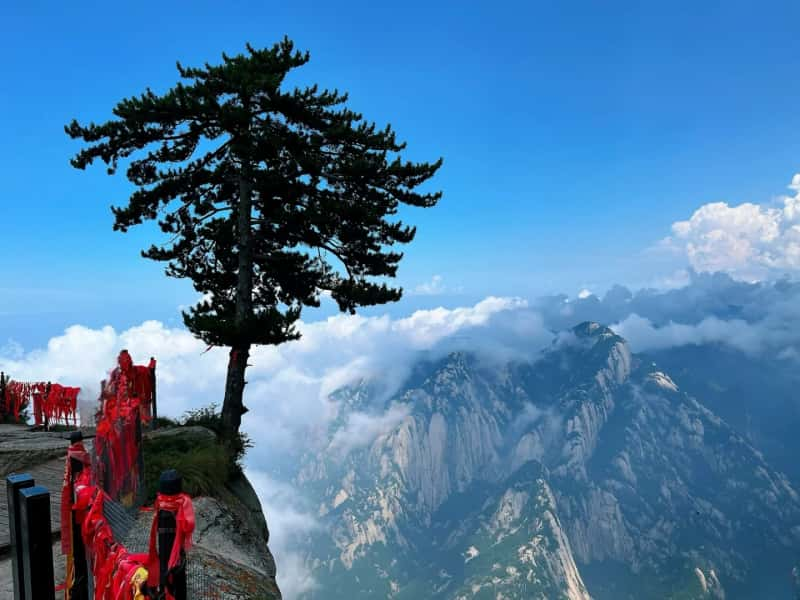
Middle Peak (Jade Maiden Peak)
Situated at the center of the East, South, and West Peaks, Middle Peak, or Yu Nv Feng, is named after a Taoist legend involving Qin Mugong’s daughter and her love story with Xiao Shi. The peak features several sites tied to the story, including the Jade Maiden Pavilion, Phoenix Platform, and various sacred trees. The peak is also known for its distinctive turtle-shaped rock formation, with the Jade Maiden Temple perched atop the “turtle’s back.”
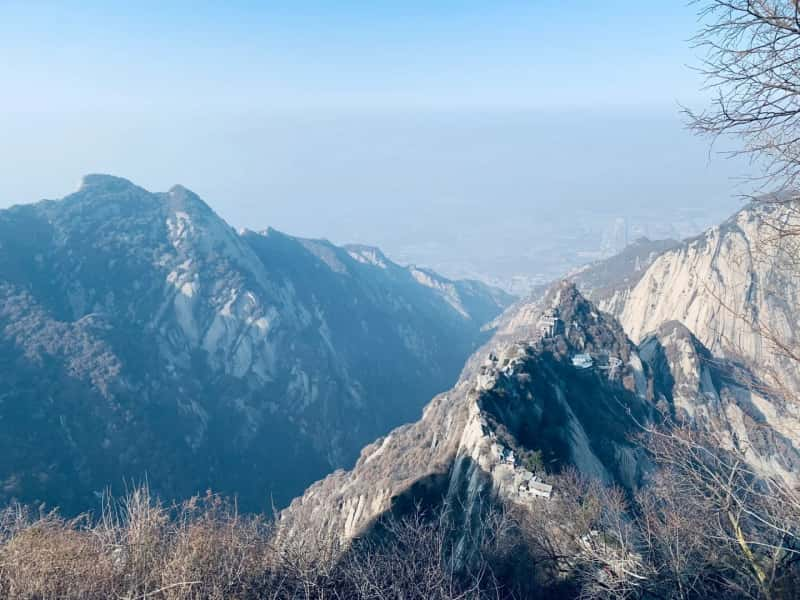
Mount Hua Ticket Guide for Visitors
Mount Hua requires a combination of tickets depending on your chosen route. Tickets include entrance fees, shuttle bus tickets (for both uphill and downhill routes), and cable car tickets (uphill and downhill). Below is a detailed breakdown of ticket options, prices, and routes to help you plan your visit.
Ticket Options by Route Difficulty
- West Peak Uphill + West Peak Downhill
- Difficulty: Easy (1/10)
- Duration: 4–5 hours
- Recommended for: Families with children or elderly visitors.
- West Peak Uphill + North Peak Downhill
- Difficulty: Moderate (2/10)
- Duration: 5–7 hours
- Features: A classic and popular route, with minimal uphill hiking and more downhill walking.
- North Peak Uphill + West Peak Downhill
- Difficulty: Challenging (3/10)
- Duration: 6–8 hours
- Features: Includes a long uphill hike, making it suitable for adventurous visitors.
- Full Hiking Route (Night Climb)
- Difficulty: Extreme (10/10)
- Duration:
- Hiking up and taking the cable car down: ~10 hours
- Hiking both up and down: ~15 hours
- Recommendation: Only attempt this route if you have strong endurance and are prepared for the physical demands.
- Ticket Purchase: Trip.com Discounts
Ticket Prices
Seasons:
- High Season: March 1–November 30
- Low Season: December 1–February 28
Route 1: West Peak Uphill + West Peak Downhill
- Included: Entrance fee, round-trip shuttle bus tickets, and round-trip cable car tickets.
- Prices:
- Adults: ¥520 (high season), ¥420 (low season)
- Entrance fee: ¥160 (high season), ¥100 (low season)
- Shuttle bus: ¥80 (round trip)
- Cable car: ¥140 (one way, high season), ¥120 (one way, low season)
- Children (1.2m–1.5m): ¥210 (low season only)
- Students: ¥346 (low season only)
- Seniors (60–64 years): ¥372 (low season only)
- Seniors (65+ years): ¥272 (low season only)
- Free entry: Children under 6 years old or shorter than 1.2 meters.
- Adults: ¥520 (high season), ¥420 (low season)
- Check-in Point: Visitor Center Ticket Hall
Route 2: West Peak Uphill + North Peak Downhill (Most Popular)
- Included: Entrance fee, West Peak shuttle bus ticket, West Peak uphill cable car, North Peak downhill cable car, and North Peak shuttle bus ticket.
- Prices:
- Adults: ¥440 (high season), ¥325 (low season)
- Entrance fee: ¥160 (high season), ¥100 (low season)
- West Peak shuttle bus: ¥40
- West Peak uphill cable car: ¥140 (high season), ¥120 (low season)
- North Peak downhill cable car: ¥80 (high season), ¥45 (low season)
- North Peak shuttle bus: ¥20
- Children (1.2m–1.5m): ¥165 (low season only)
- Students: ¥259 (low season only)
- Seniors (60–64 years): ¥292 (low season only)
- Seniors (65+ years): ¥192 (low season only)
- Free entry: Children under 6 years old or shorter than 1.2 meters.
- Adults: ¥440 (high season), ¥325 (low season)
- Check-in Point: Visitor Center Ticket Hall
Route 3: North Peak Uphill + West Peak Downhill
- Included: Entrance fee, North Peak shuttle bus ticket, North Peak uphill cable car, West Peak downhill cable car, and West Peak shuttle bus ticket.
- Prices:
- Adults: ¥440 (high season), ¥325 (low season)
- Entrance fee: ¥160 (high season), ¥100 (low season)
- North Peak shuttle bus: ¥20
- North Peak uphill cable car: ¥80 (high season), ¥45 (low season)
- West Peak downhill cable car: ¥140 (high season), ¥120 (low season)
- West Peak shuttle bus: ¥40
- Children (1.2m–1.5m): ¥165 (low season only)
- Students: ¥259 (low season only)
- Seniors (60–64 years): ¥292 (low season only)
- Seniors (65+ years): ¥192 (low season only)
- Free entry: Children under 6 years old or shorter than 1.2 meters.
- Adults: ¥440 (high season), ¥325 (low season)
- Check-in Point: Visitor Center Ticket Hall
Route 4: Full Hiking Route
- Included: Entrance fee, West Peak downhill cable car, and West Peak shuttle bus ticket.
- Prices:
- Adults: ¥340 (high season), ¥260 (low season)
- Entrance fee: ¥160 (high season), ¥100 (low season)
- West Peak downhill cable car: ¥140 (high season), ¥120 (low season)
- West Peak shuttle bus: ¥40
- Students: ¥246 (high season), ¥198 (low season)
- Adults: ¥340 (high season), ¥260 (low season)
- Check-in Point: Yuquan Courtyard – Huashan Gate
Operating Hours
- Cable Car Stations:
- Ticket checks: 7:00 AM to 4:00 PM
- Operations: 7:00 AM to 7:00 PM
- Huashan Gate (Walking Entrance): Open 24 hours
How to Purchase Tickets
- Online: Through the official Mount Hua WeChat account or third-party travel platforms.
- Ticket Purchase: Trip.com Discounts
- In-person:
- For non-hikers: Visit the Visitor Center’s ticket office with your passport.
- For hikers: Buy tickets at Yuquan Courtyard with your passport.
Recommended Hiking Routes at Mount Hua
Exploring Mount Hua offers a range of hiking routes tailored to different skill levels and interests. Here are the most popular trails:
West Peak Uphill + West Peak Downhill Route
- Itinerary: Visitor Center ➡️ West Peak Cable Car (40 minutes) ➡️ Central Peak (1-hour hike) ➡️ East Peak (40-minute hike) ➡️ South Peak (1-hour hike) ➡️ West Peak (30-minute hike) ➡️ West Peak Cable Car Downhill (20 minutes).
- Difficulty: Easy (1/10)
- Duration: 4–5 hours
- Best for: Families with children or elderly travelers who prefer a relaxing hike.
West Peak Uphill + North Peak Downhill Route
- Itinerary: Visitor Center ➡️ West Peak Cable Car (40 minutes) ➡️ South Peak (30-minute hike) ➡️ East Peak (1-hour hike) ➡️ Central Peak (40-minute hike) ➡️ North Peak (2-hour hike) ➡️ North Peak Cable Car Downhill (8 minutes).
- Difficulty: Moderate (2/10)
- Duration: 5–7 hours
- Why Choose This: A classic choice with minimal uphill hiking and more downhill walking. It’s the most popular route among visitors.
North Peak Uphill + West Peak Downhill Route
- Itinerary: Visitor Center ➡️ North Peak Cable Car (20 minutes) ➡️ North Peak (8 minutes) ➡️ Central Peak (2-hour hike) ➡️ East Peak (40-minute hike) ➡️ South Peak (1-hour hike) ➡️ West Peak (1-hour hike) ➡️ West Peak Cable Car Downhill (20 minutes).
- Difficulty: Challenging (3/10)
- Duration: 6–8 hours
- For Whom: Adventurous hikers seeking a more demanding trail with a significant uphill climb.
Full Hiking Route
- Itinerary: Yuquan Courtyard ➡️ Huashan Gate ➡️ North Peak (5-hour hike) ➡️ Central Peak (2-hour hike) ➡️ East Peak (40-minute hike) ➡️ South Peak (1-hour hike) ➡️ West Peak (1-hour hike) ➡️ West Peak Cable Car Downhill (20 minutes).
- Difficulty: Extreme (10/10)
- Duration:
- Hiking uphill + cable car downhill: ~10 hours
- Hiking both uphill and downhill: ~15 hours
- Recommendation: This route is ideal for highly experienced hikers with excellent stamina and a desire for a full-on adventure.
Night Climbing Route
Night climbing at Mount Hua offers a unique way to experience the mountain’s serene beauty and catch the sunrise:
- Itinerary: Yuquan Courtyard (starting point) ➡️ North Peak ➡️ Central Peak ➡️ East Peak (sunrise viewing) ➡️ South Peak (including the Chang Kong Cliff Walk) ➡️ West Peak (cable car downhill).
- Best Sunrise Spot: East Peak
- Climbing Time: Start between 9:00 PM and 10:00 PM the night before. For a front-row spot at sunrise, leave one or two hours earlier.
Must-Bring Items for Night Climbing
- Portable charger: Lightweight and essential for keeping your devices powered.
- Gloves: Available at mountain shops or train stations; useful for gripping chains.
- Wet wipes and tissues: Some restrooms lack running water.
- Snacks: Energy-boosting items like beef jerky, protein bars, or nuts.
- Clothing: A light down jacket or windbreaker is recommended as temperatures drop at night. Heavy coats are available for rent at the summit.
- Sunglasses: Perfect for daytime photos or shielding your eyes from the sun.
- Rain gear: Pack a lightweight rain poncho, especially if rain is forecast.
- Lightweight backpack: Carry only essentials to conserve energy during the climb.
Sunrise and Sunset Timings at Mount Hua
Sunrise Timings
- Spring (March–May): Around 5:00–6:00 AM
- Summer (June–August): Around 4:30–5:20 AM
- Autumn (September–November): Around 6:15–6:29 AM
- Winter (December–February): Around 5:30–6:00 AM
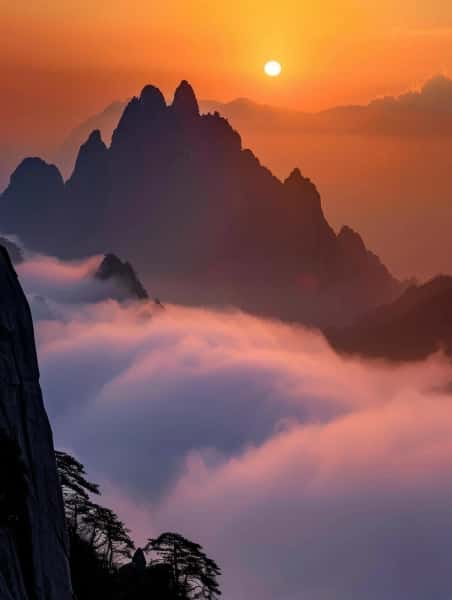
Sunset Timings
- Summer: Around 6:30 PM
- Winter: Around 5:00 PM
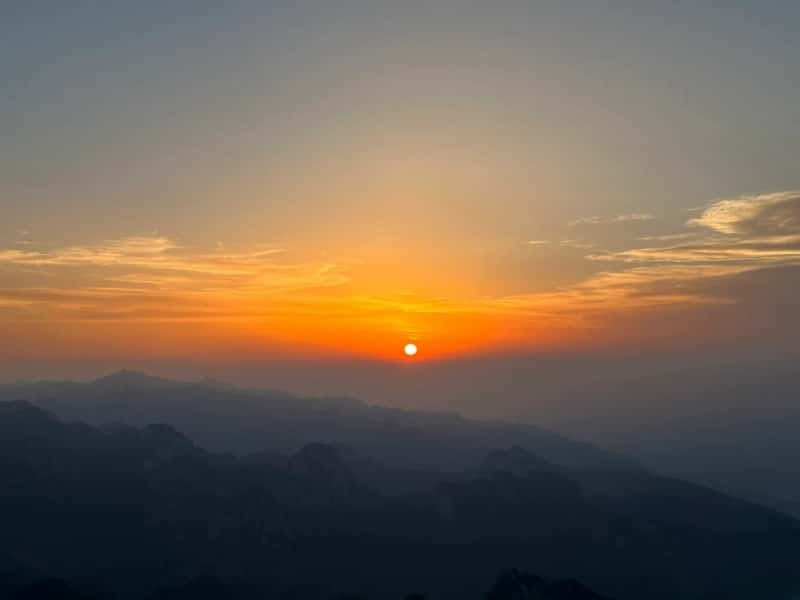
Best Viewing Spots
- Sunrise: East Peak, known as Sunrise Peak, offers the most breathtaking views of the first rays of sunlight breaking over the rugged peaks.
- Sunset: West Peak provides a stunning scene as the sun dips below the horizon, casting golden light over the cliffs.
Post-Hike Tips for Mount Hua
To ensure a comfortable and safe experience after your Mount Hua adventure, here are some practical tips:
- Bring Gloves: Purchase gloves at the base of the mountain. They’re essential for gripping chains, providing both slip resistance and cleanliness.
- Hiking Poles: Optional. They’re slightly useful on the North Peak descent but mostly unnecessary for other routes.
- Watch Your Step: In March, some trails may still have residual snow or become slippery due to melting ice. If needed, purchase anti-slip shoe spikes at the base.
- Pack Light Snacks: Carry two bottles of sports drinks and a few protein bars, like chocolate or jerky. Water is available for purchase along the trail.
- Portable Charger: Keep one handy, as taking photos can quickly drain your phone battery.
- Skip Extra Tour Guides: While some group tours offer audio guides, most hikers are too busy climbing or taking photos to listen.
- Dress Appropriately: Except for night hikes, dress as you would in Xi’an. You’ll warm up quickly while climbing, so layers you can remove are ideal.
- Restroom Tips: Avoid mountain toilets—they can be unpleasant. Plan a restroom break at the cable car station before starting your hike.
- Stretch After Descending: Perform a quick stretch before sitting in a car to prevent soreness after your hike.
Best Time to Visit Mount Hua
Mount Hua offers distinct seasonal beauty, making it a year-round destination. Here’s what to expect in each season:
Spring (March–May)
In spring, Mount Hua awakens with blooming flowers and lush greenery. The mild temperatures, averaging between 3.7°C and 19.5°C, make it an ideal season for hiking. Morning hikes to East Peak (Sunrise Peak) also reward you with spectacular sunrises. Although spring sees occasional rain, it’s often free from fog, providing clear views of the mountain’s natural beauty.
Summer (June–August)
Despite higher temperatures in summer, Mount Hua’s elevation keeps it relatively cool and refreshing. Afternoon rain showers are common but brief, often followed by clear skies. Summer is perfect for viewing cascading waterfalls and cloud seas. Starry skies and fireflies illuminate the mountain at night, making it an enchanting time for night hikes. Start early in the morning or late in the afternoon to avoid crowds and heat.
Autumn (September–November)
Autumn is arguably the best time to visit Mount Hua, with cool, crisp weather and breathtaking fall foliage. Red, orange, and golden leaves blanket the landscape, creating postcard-perfect scenes. Popular spots like the Thousand-Foot Precipice, Hundred-Foot Gorge, North Peak, and Canglong Ridge become even more picturesque in this season. Although it’s a peak tourist period, quieter hiking times are still available early in the morning or on weekdays.
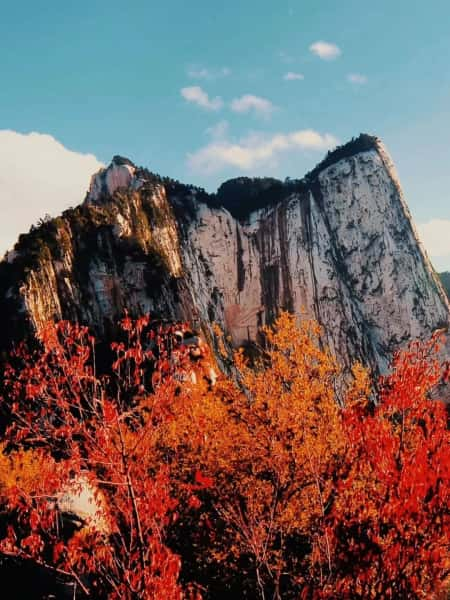
Winter (December–February)
Winter transforms Mount Hua into a snowy wonderland, with fewer tourists and a tranquil atmosphere. The snow-covered peaks, trees, and temples exude a serene charm. North Peak, in particular, shines as frost and sunlight create a glittering spectacle. Although temperatures can be frigid, the calm and solitude of winter hiking make it a unique and rewarding experience.
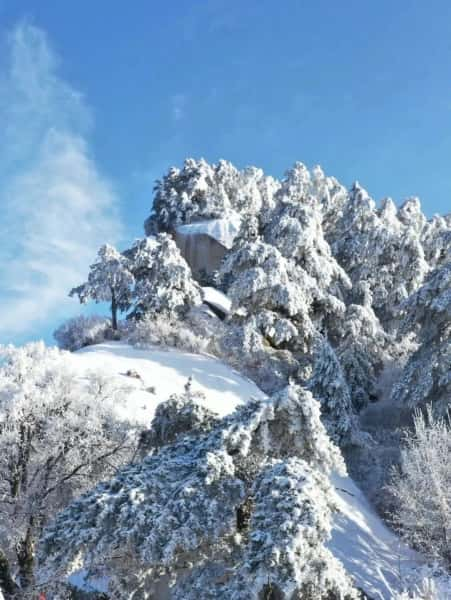
How to Get from Xi’an to Mount Hua
By Air
Although Mount Hua doesn’t have its own airport, visitors can easily connect through Xi’an Xianyang International Airport:
- From the airport, take the airport shuttle to Xi’an North Railway Station (approximately 50 minutes).
- Board a high-speed train to Mount Hua North Station, which takes about 30 minutes.
- From Mount Hua North Station, take a shuttle bus or taxi to the Mount Hua Visitor Center.
- Best for: Travelers flying into Xi’an with extra time to spare.
By Direct Tourist Bus
Tourist buses to Mount Hua are available from various locations in Xi’an:
- Departure Points: Xi’an Railway Station, Bell Tower, and major tourist hubs in the city center.
- Travel Time: Approximately 2 hours.
- Advantages: Convenient, direct, and no need for transfers.
- Cost: ¥30–50 per person, depending on departure location.
- Best for: Visitors looking for an affordable and hassle-free option.
By Metro + High-Speed Train
- Metro: Take Line 4 to Xi’an North Railway Station (around 30 minutes).
- High-Speed Train: Travel to Mount Hua North Station (around 30 minutes). Trains run frequently.
- Final Transfer: From Mount Hua North Station, use a shuttle bus, taxi, or shared bike to reach the Visitor Center.
- Best for: Travelers prioritizing speed and flexibility.
By Taxi or Rideshare
- Travel Time: About 2 hours, depending on traffic.
- Cost: ¥300–500 for a one-way trip. Consider sharing a ride to split the cost.
- Best for: Groups of friends or families seeking convenience and comfort.
Accommodations at Mount Hua
Hotels at the Foot of Mount Hua
Staying at the base of Mount Hua offers convenience and comfort. Here are some excellent options:
Shaanxi Dijing Nanshan (Mount Hua) Hot Spring Hotel
A premium hotel situated at the foot of Mount Hua, known for its luxurious facilities and stunning views:
- Price: ¥600 per night
- Features: Each room includes a large balcony with floor-to-ceiling windows, offering breathtaking views of Mount Hua—perfect for capturing sunset photos.
- Recommended Activities: Climb Mount Hua during the day and unwind with a relaxing hot spring soak in the evening to ease your muscles.
- Extra Perks: Located just a 5-minute walk from Huashan Ice and Snow World, making it a great choice for winter visitors who also enjoy skiing.
- Best For: Families, couples, and those who appreciate a touch of luxury.
Hotels at the Summit of Mount Hua
For travelers who want to catch the sunrise or rest after a long hike, Mount Hua offers basic accommodations at several key locations near the peaks:
- North Peak Hotel
- Wuyun Peak Hotel (near Canglong Ridge)
- East Peak Hotel
- West Peak Hotel
- East Peak Capsule Hotel (offers capsule-style rooms at a relatively lower price).
Important Notes:
- Price: Typically ¥1,000+ per night, with higher prices during peak seasons.
- Facilities: Simple and utilitarian, these accommodations are best for short stays or as a place to rest and recharge.
- Recommendation: If you prefer more comfort, stay at a hotel at the mountain’s base. Summit accommodations are ideal for those determined to see the sunrise.
Food Recommendations at Mount Hua
Dining on Mount Hua
Despite the steep terrain, there are several food options along the hiking trails:
- Meal Prices: Around ¥40 per meal. The food is simple but sufficient for regaining energy.
- Drink Prices: Prices for bottled water increase with altitude, ranging from ¥10 for three bottles at the base to ¥12 for two bottles at the summit. Stock up on drinks and snacks before beginning your hike.
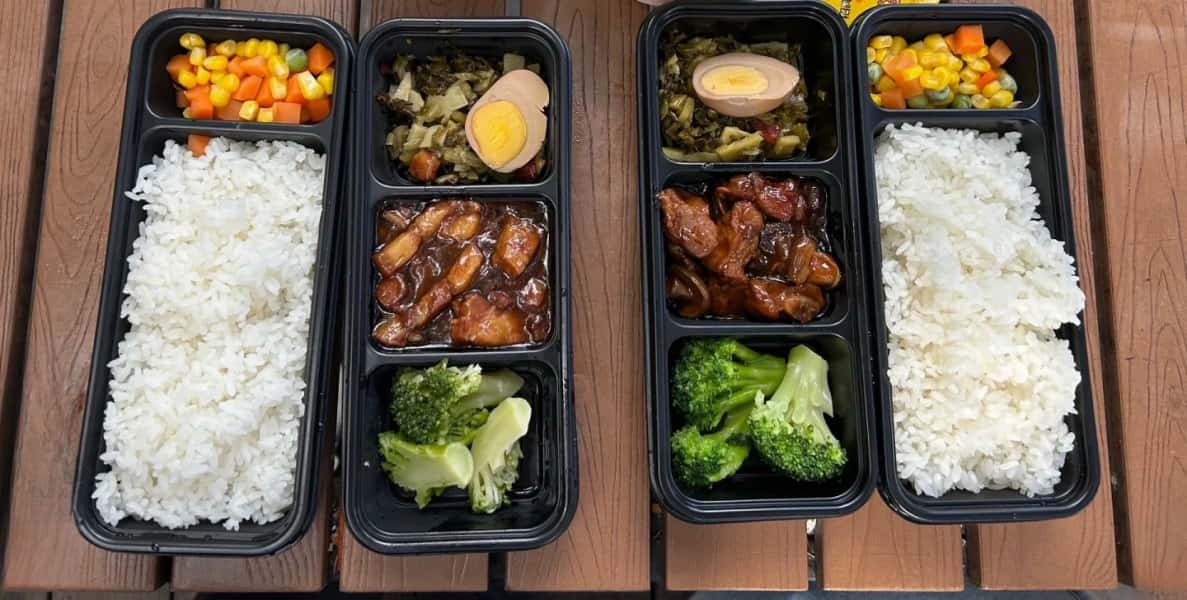
Dining at the Foot of Mount Hua
The area around the Visitor Center and cable car stations offers a wide variety of food options:
- Fast-Food Chains: Options like KFC provide quick and convenient meals for travelers short on time.
- Local Delicacies: Don’t miss out on trying Roujiamo (Chinese-style burgers) and Liangpi (cold noodles), two of Shaanxi’s signature dishes. These are flavorful, affordable, and a must-try.
- Other Restaurants: Many sit-down restaurants near the service center offer hot meals and set menus, making them a good choice for groups or families.
FAQ
Do I Need to Reserve Tickets and Cable Car Rides in Advance?
While reservations aren’t mandatory, buying tickets in advance is highly recommended. Weather conditions can sometimes cause temporary closures of attractions or cable cars, so checking the latest updates before your visit is essential.
Is Mount Hua Suitable for Baby Strollers?
Mount Hua is not suitable for baby strollers. Here’s why:
- The trails are steep and consist mostly of stairs, making strollers impractical.
- If you’re traveling with young children, using a baby carrier or sling is safer and more convenient.
- For families with young kids, opt for an easier route like West Peak Uphill + West Peak Downhill to minimize physical strain.
Where Can I Store Luggage?
The Visitor Center near Mount Hua provides secure luggage storage facilities for travelers:
- Prices:
- Suitcases: ¥20 per item
- Backpacks: ¥10 per item
- Operating Hours: Open until midnight, accommodating night climbers and late-returning hikers.
- Location: Clearly marked with signage. Visitor Center staff can also assist you in finding the storage area.
Essential Xi’an Travel Resources
- Comprehensive Xi’an Travel Guide 📖
- Hotel Recommendations 🏨
- Transportation Guides ✈️ 🚇 🚄 🚆
- Essential Travel Tips & Tools 🗺️ 🍜 📱 💸 🌤️ 💊

 English (US)
English (US)
 繁體中文
繁體中文 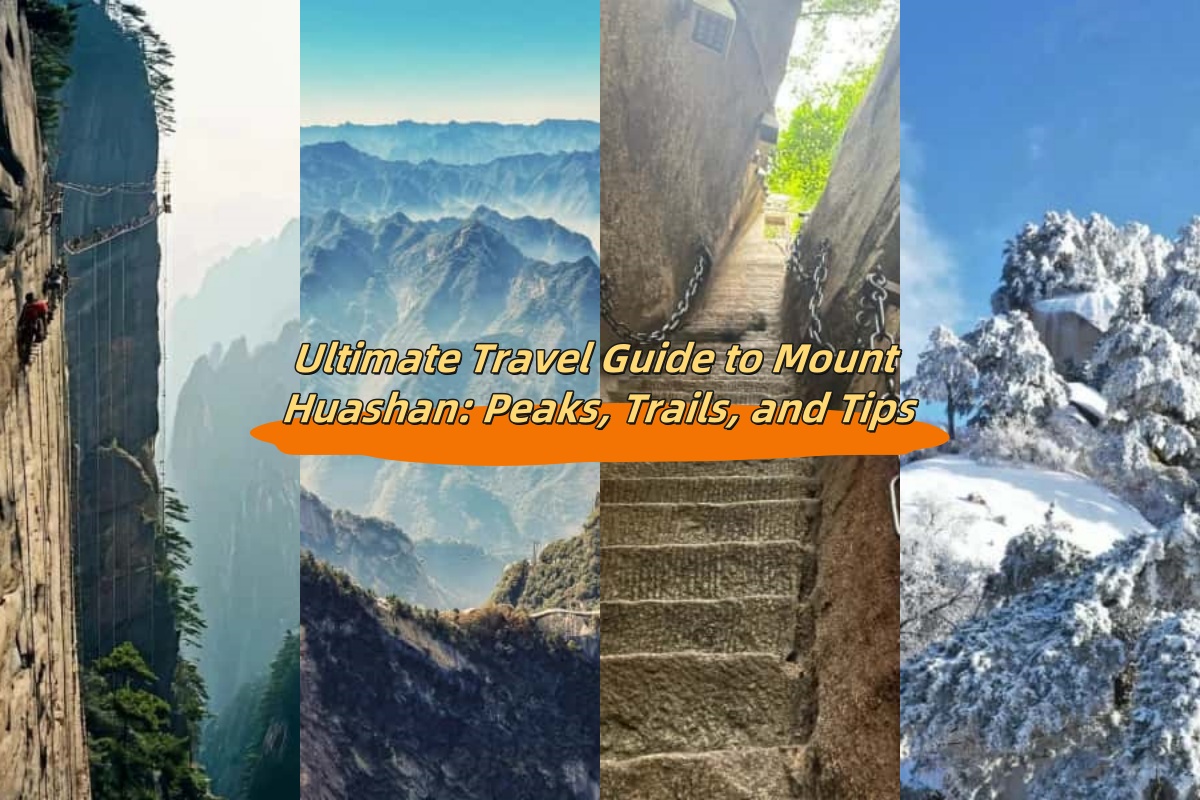
Comment (0)